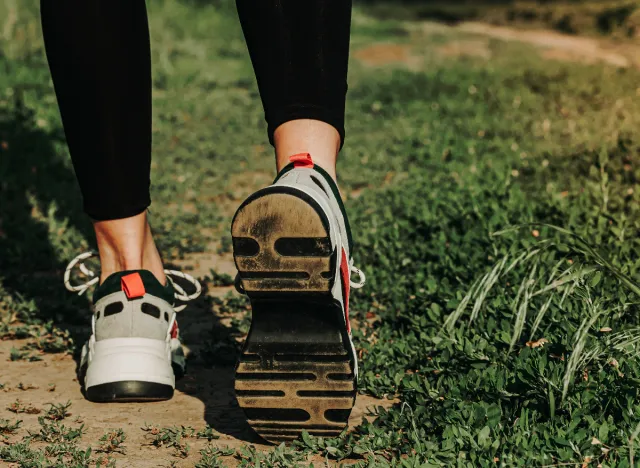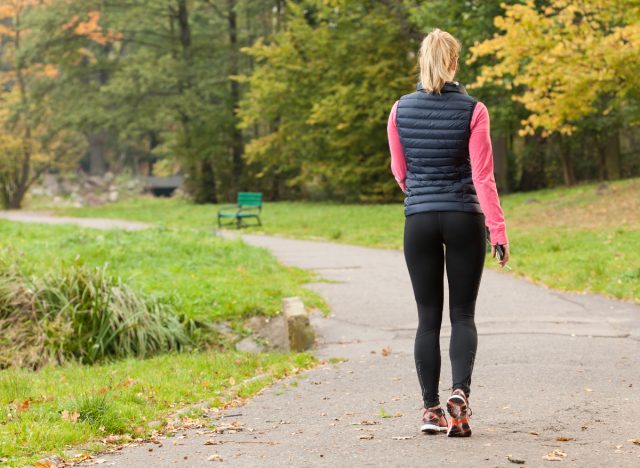People Are Ditching Regular Walks for 'Rucking': 'The Transformation of My Body Is Real'

If you're a walker, listen up. People are trading in their regular walks and strolls for a more productive form of physical activity called "rucking." This modified form of walking bumps up the intensity and requires you to wear a heavy rucksack or backpack while you're getting in your steps. This way, you're soaking up the benefits of both cardio and strength training all in the same session.
You may be wondering what a rucksack is. We spoke with an expert who fills us in on that, along with everything else you should know about this popular form of exercise and its benefits.
"A rucksack is basically a special type of backpack that's better suited for this sort of activity than the average backpack would be," explains Domenic Angelino, CPT, from Trainer Academy. You can also purchase weights that are specifically designed to weigh down your rucksack to make it an even more effective workout. As you continue, increasing the amount of weight in your rucksack is a natural progression.
"Once you have your rucksack filled, it's important to make sure you wear it with straps that are appropriately fastened, since having straps that are too loose can cause the rucksack to sag behind you which can make for an uncomfortable rucking experience," Angelino points out.
Now that you understand the process, all you have to do is make sure your rucksack is on the tighter side, and you can get started! But before you gear up, read on to learn the benefits of rucking.
How is rucking a more beneficial exercise than walking?
Rucking is an extraordinary way to build your upper-body muscles and increase muscular endurance. It's a great workout for your abs, back, and shoulder muscles, and it will help you torch more calories than walking.
"[Rucking] increases the muscular endurance of those muscles [as] they are required to support the weight of the rucksack over the course of your walk," Angelino tells us. "Those muscles need to isometrically contract in a way that is sustained over a long period of time, which is why it specifically impacts their endurance."
Wearing a rucksack on your back adds to the weight you're carrying, which requires your legs to use more force with every step you take to continue your stride. This, combined with the extra work your upper-body muscles are using to keep the rucksack stable, increases your total calorie burn.
The calf muscles in your lower body will benefit the most because of their structure. Every step you take will force your calves through a higher proportional range of motion than the other muscles in your lower body.
The cardiovascular benefits are also amazing. "Rucking can provide a greater cardiovascular stimulus than regular walking, which means rucking is better for your heart health," Angelino tells us. "This is because your heart will have to deliver a lot more blood and oxygen to your muscles over time so that it can support all the extra work they're doing."
If you need more convincing, check out how people on TikTok are raving about the benefits of rucking. TikTok user @dailycleansewithceleste explained in a video, "I'm rucking wearing my new 50-pound vest … the transformation of my body is real!" She added in the caption, "My entire body is being reshaped and transformed by wearing the vest while walking."
Tips for starting your rucking workout:

1. Get creative with your rucking weights.
You can really use anything you have access to to add weight to your rucksack. "As long as your rucksack is as heavy as you want, it can work," Angelino says. "You can get creative with household objects like books or cans of food. You can also grab a number of rocks outside and start filling up your rucksack."
Remember to stay away from sharp objects that may be uncomfortable or harm your back while you're walking. Flatter items that are in place close to your back will make the experience smoother and more comfortable.
2. There are plenty of choices as to where you can go rucking.

Rucking is fun on hiking trails but can also be performed on your regular walking route. "It's totally fine for you to go rucking around your neighborhood or even around a local track," Angelino offers. "What matters most is that you're moving your body and have a weighted rucksack on."
3. Make sure you bring the essentials.
Before you head out on your rucking adventure, make sure you're equipped with the necessities, such as water, sunscreen, healthy snacks, and even bug spray, depending on your route and plan.
"You should ideally drink enough water to replace the amount of water you lose through sweat over the course of your workout," Angelino explains. "High-carbohydrate snacks help you increase your blood glucose which can provide you with energy if you were running low."
4. Choose a high-quality rucksack.
If you're investing in a new rucksack, Angelino encourages you to go with quality. A good rucksack is designed for durability and to distribute weight evenly on your back, which will make you much more comfortable.
It's also important to look for a rucksack with a waist strap, which will decrease the load on your back muscles. "This will make it easier for you to go rucking for longer periods at a time," Angelino says. "If you don't use a waist strap, your back muscles will be more taxed and their muscular endurance will resultantly improve."
5. As with any exercise, it's important to warm up.

Don't forget your warm-up for this workout! According to Angelino, "You can ease into a heavy rucking session if you want by incorporating a warm-up. Start by walking for two to three minutes without your rucksack on. Then, put on your rucksack with it half-filled so that it's half as heavy as it normally would be. Then, walk around for another two to three minutes. Afterward, fill up the rucksack completely and begin your main workout. This approach can make rucking more tolerable than going from 0 to 100 right out of the gate."
6. If you lift weights, factor your rucking session into your weekly schedule.
If you lift weights, it's imperative to consider your rucking session when planning your lifting schedule and avoid rucking on days you plan to lift.
"Rucking before certain types of workouts can reduce your workout quality and increase your risk of injury," cautions Angelino. "It's best to avoid rucking before a lower-body workout day that involves weights. It's also best to avoid rucking before any lifting session that places a lot of stress on your lower back."
7. Consider incorporating hills to further increase the intensity.
Adding weights to your rucksack is not the only way to increase the intensity of your workout. You can add hills to your routine and transition from walking to running. Every form of intensity provides benefits, and the sky is the limit.









